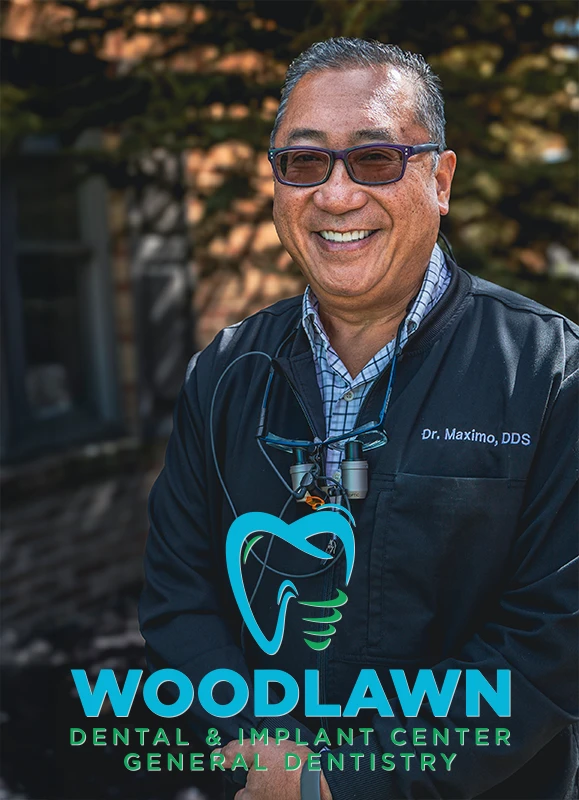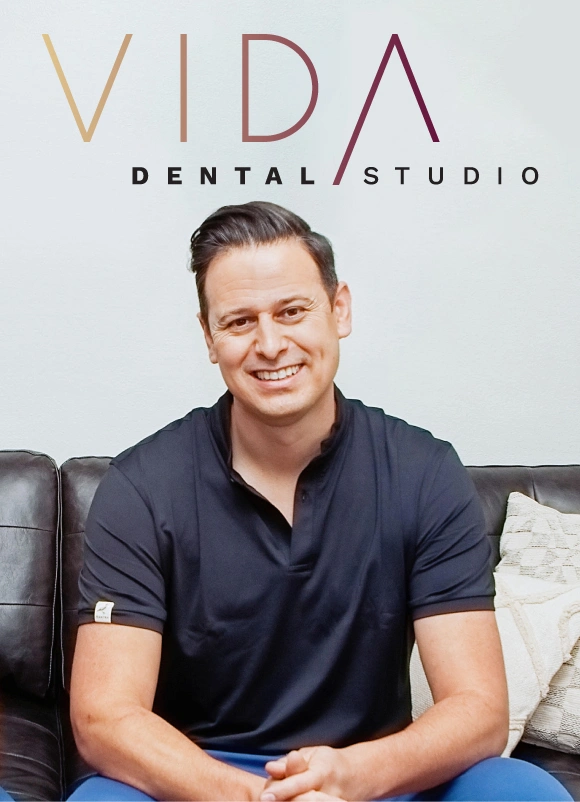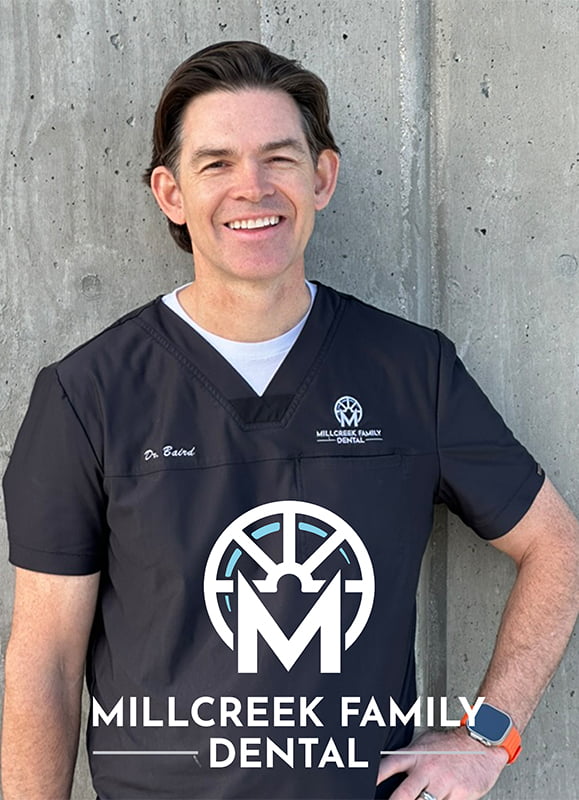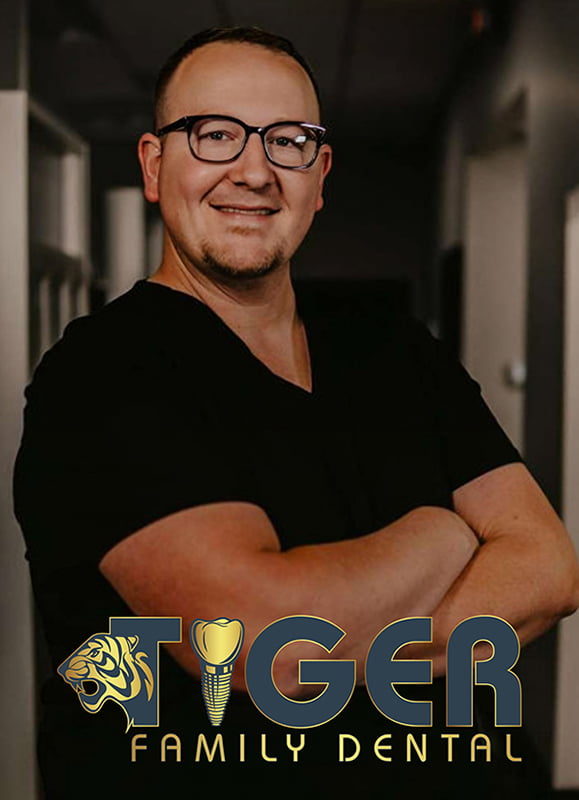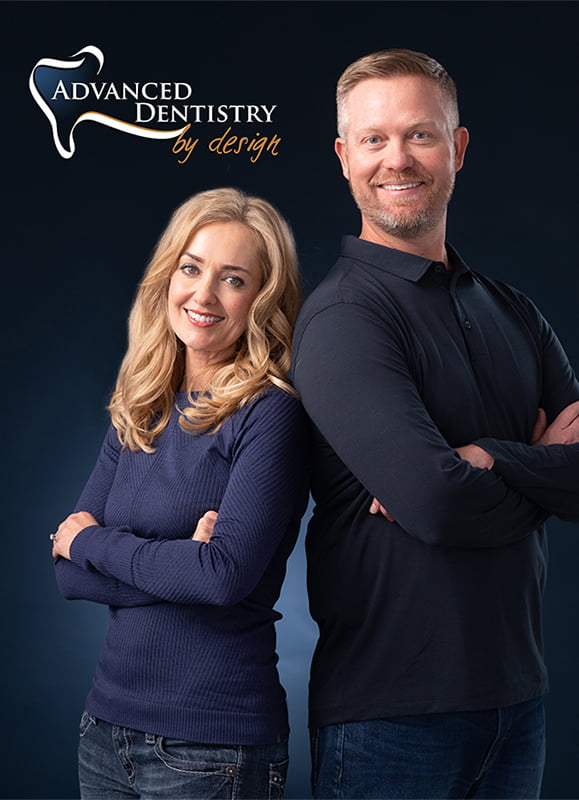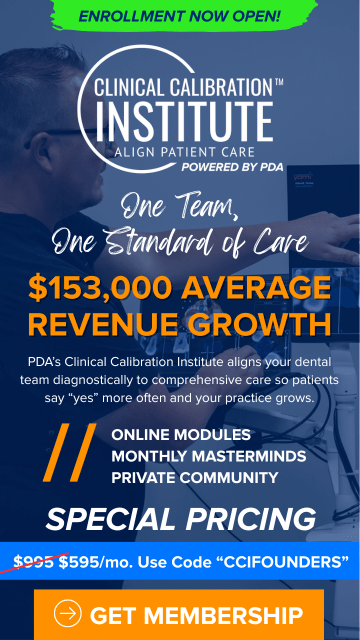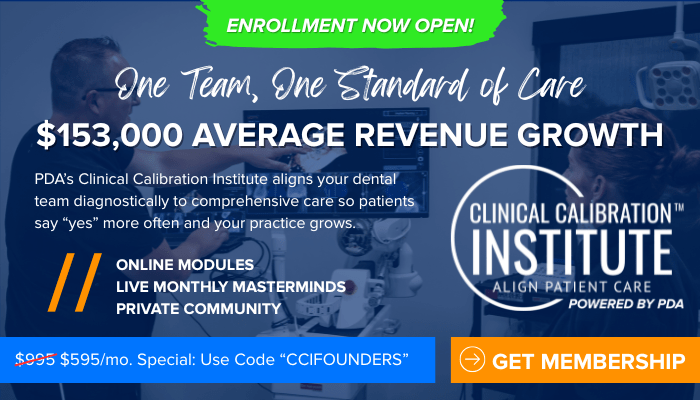Episode 117 – Next-Level Communication with Dr. Kelsey Meunier and Dr. Anna Adams
“The risk factor conversation has been so crucial in communicating to patients and is what I think has elevated our practice to the next level,” says Dr. Kelsey Meunier who joins us today with Dr. Anna Adams to share their story about doubling production through communication. If you’ve ever felt that you have all the knowledge in your head but struggle to help patients understand the care they need, then you don’t want to miss this episode. Join us as we dive into how these two vibrant doctors elevated their patient care – and their bottom line – to the next level by:
- Growing their confidence with effective case presentation communication
- Increasing profit through patient-centered care
- Elevating purpose-driven outcomes
EPISODE TRANSCRIPT
KELSEY: Productive Dentist Academy is an amazing way of kind of structuring in your head, the right way to talk to patients and the right way to take better care of people and in return the amount that you’re producing go up. Because if you’re truly following what PDA is recommending, your numbers will 100% go up. It’s especially the risk factor conversation. I feel like that’s been so crucial and properly communication, what’s needed. And it’s that ultimately, I think, has been what has totally elevated our practice to the next level.
REGAN: Welcome to another episode of Everyday Practices Podcast. I’m your co host, Reagan Robertson. Doctors, would you be surprised to know that you can double your case acceptance not by decreasing fees, not by doing single tooth procedures only. But by improving the way you communicate? research shows businesses with highly effective communicators have a 47% higher total return compared to others. And the highly successful practice we are about to interview today more than doubled production from simply improving communication.
Whether you were a doctor, owner or associate you can control your outcomes and support a seamless patient experience that has people returning again and again for your care. In today’s episode, Dr. Chad Johnson and I are honored to sit down with doctors Kelsey Meunier, and Dr. Anna Adams, to associate doctors at Fuqua Family Dentistry in North Carolina, we tackle highly effective case presentation communication, increasing profit through patient advocacy, and how to elevate purpose driven outcomes. If you’ve ever felt like you have a lot of science in your head, and it’s difficult to get patients to say yes to the care they need, you’ll want to listen to this. Let’s get into it.
I don’t know if I’m more so excited than normal, because I say if you ever listened to our podcast, if you have, but I say I’m excited pretty much every episode, but what’s really interesting, I know, for different reasons, for different reasons. And and I saw I read the pre interview notes from Kashmere, and one I love Bryden. So I’ve known Brian McCormack for several years. Chad, you’ve known Bryden for a while, right? Yeah. And, and your stories are really fascinating. And I think what’s going to resonate is the honesty that comes from like, now I know, Dr. Anna, you were, you know, kind of quick to pick up the PDM methodology and learning different ways to communicate with patients if I understand, right, but Kelsey, you know, you had a little bit of that skepticism out of the gate, you’d been burned. And you’re were you pregnant, you were pregnant.
KELSEY: When I was pregnant? Yes. So I yeah. But by the time that I, I guess kind of backtrack a little bit. So when I graduated in 2011, I joined a practice with a owner doctor who had never had an associate. And his expectations as to what an associate wanted was completely unrealistic. And I learned after being there a little less than a year, this was not a good fit. And I had reached out to an orthodontist, friend of mine, saying, Hey, I think I’m going to start looking again, do you know of anyone looking for an associate. And she was like, actually, I do know a guy in North Carolina, who was Fred McCormack and gave me Brian’s info and we met and he had an associate the same age as me, that also wasn’t a good fit. So we connected quickly, and I think on both of our past experiences, learn to kind of appreciate each other. And in the beginning of our relationship, we, we just practice on doing good dentistry, we never paid attention to numbers, we never really paid attention to, you know what our goals were, so to speak, we just kind of did what worked. And after being there for about three years, he kind of got to the point where he was like, I know we’re capable, more.
And I know, he was getting kind of frustrated with me and felt that especially my communication skills with patients definitely has some room for improvement. And so he approached me when I was about seven months pregnant with my first child, kind of being like, Hey, we’re doing this and I need you to go to Texas.
And you know, I’m in my third trimester. And it definitely, you know, caused a lot of kind of heated conversation on our points. And I had actually been with a different consulting firm and my first associate ship that just created some power struggles with people it created egos and hierarchies and everything there was about numbers, numbers were the only thing that matters. So I had never really heard about PDA that was very skeptical when I heard you know, consulting group coaching group, I was like, Oh, no, I am not doing this again. So I definitely came in with quite a bit of skepticism.
REGAN: And that’s, that’s where so for me, that was where I really wanted to go deep into the story, because this is all part of a journey. I mean, it really is it kind of folds and blossoms as it goes in. And as I was sharing Kelsey with, with Chad and Anna, right before we began recording, I have my son in the other room with me, he’s six years old, because it’s a day off and my husband’s traveling at work. And I’m like, okay, it’s me. And I went through two pregnancies while I worked full time. So Kelsey, how did you how did you just negotiate all of these changes that were coming around? So you’d been with bryden? For a while, you felt the heat and a little bit of that frustration, like things were gonna have to change? And you were in your third trimester of pregnancy? What What did it take mentally for you to kind of say, okay, and shift and go through this.
KELSEY: It took a lot. The first thing was I said, I don’t feel comfortable traveling, and I had a high risk pregnancy, and I didn’t feel comfortable traveling, so he kind of backed off a little on the travel portion from the get go. But I think it was January of 2015, when I had my first phone conversation with Bren, who’s our PDA coach, and I’m sure if you talk to Bren she probably laughed at that conversation. Because I came in with walls up I’m I know, I probably came across as a not very nice person to her. But I think it probably wasn’t until maybe the second or third conversation I had with Bren where I was like, Okay, this is not this is different. This is not about the numbers.
That’s not the end all be all. It’s really truly, what can I do as a dental provider to really help my patience. And truly, I mean, that’s why I went to dental school to begin with was not about numbers was to help people. And so the PDA philosophies were something completely different than anything I had been either taught in dental school or has learned so far and my dental career. So I think it was just learning what PDA was truly about. And, you know, slowly, one by one, I kind of took the walls down and started to really kind of integrate it into something that I now use daily. When I practice.
REGAN: Wow. So when you I loved your why going into help people and from that space of it. When was it? When was it realization to you that numbers, were something that you were going to look at as a practice? Because I think for everyone, I mean, I can’t speak for everyone, I can speak for me like for me, it’s just I want everybody to know that there’s support available, like if I miss one dentist that needed this help in this specific area, and we could provide it and they miss it like, oh, like what a heartbreak for that. But when you talk about money, it can get really crunchy because it’s you know, I don’t really care about that. It’s not about that it’s about helping.
KELSEY: Yeah, I completely agree with that. So we January 2015, was when we kind of slowly opened the door to PDA. And it was a very gradual transition throughout that calendar year. First, it was just Bryden and myself talking with Bren and then in, I think it was May, when I was still on maternity leave, he had our office manager and I believe his assistants and hygienists go down to do the full PDA seminar training with Bruce and Vicki and in Texas, and then our entire team, which at that point I want to say was maybe around 15 people went to Texas in September.
And it was at that point where we really were, I mean, the whole team was, was in so I think it wasn’t like completely diving into the deep end. First, we were taking baby steps, just kind of slowly getting one team member integrated at a time. But I think that was that was important just because we had been practicing with the same team members for such a long time that it was, you know, first and foremost bryden had to buy into it, I had to buy into it. And then once I think the team saw the commitment that we had to doing this, it got it got exciting. And then when Bren came for her first on site meeting, I think that was when the excitement really kind of took off. And there was a lot of you know, fear and hesitation at first especially being like overwhelmed and afraid of brand. But now honestly, when Bren comes to visit it, we look forward to it. We truly do.
CHAD: I have a supposition of the answer and I’ll tell you afterwards, but I don’t want to tarnish it. Why were you afraid?
KELSEY: Um, I well, so with me, so my first associate ship the way that they worked, it was very much this weird hierarchy system where so as the associate dentist, my boss was actually the clinical team leader which was the head, dental assistant. And it was just it was all Very strange. And so I was I saw the egos that that had. And so when we joined PDA, I was afraid that it was going to, you know, create egos from people that had been at that point, great team members. And I just I didn’t want it to be all about the money, I wanted it very much to be patient centered care, which, to that point had been what we were providing already. I wanted us to just be better at what we were doing.
I think that was one of the major fears. I know, when we started working with Bren doing like role playing and things like that. That wasn’t something that personally made me that uncomfortable, but a lot of our especially introverted team members that really, that really caused them to have some fear, too.
CHAD: So what was it? And again, I think I know the answer, because I was there in 2014.
KELSEY: Money. Absolutely. Yeah.
REGAN: So Kelsey, what were some of those? This is a process, what were some of those baby steps that took you from a place of frozen resistance of you know, I’m not going to be burned? Again, I’m not going to make this all about money, or whatever the those fears were, what were some of the baby steps that help you kind of peel back the onion.
KELSEY: One of the, I guess, aha moments I had was when I heard Bruce speak in Texas, and he was bringing up the fact of, you know, when you see a patient for the first time, and, you know, their mouth has all these big, you know, leaking cracking amalgams, and you know, that they need a ton of crowns. And, you know, you want to in your head, you’re like, well, maybe I should just tell them they need one or they need to, but you know, who whose fault is it that this is going on, it’s not your the dentist fault. You know, this is this is the patient’s fault.
And when risk factors are involved, it’s not the patient’s fault, it’s the risk fault, it’s the fact that they are very, very high functional risk. And then when you tie that in together, and you take the blame off the patient itself, and put the blame on the risk and why the risk is going on. To me that was so eye opening, as to Okay, I need to do what’s best for the patient. And the thing I’ve really enjoyed about being in the same practice now for going on nine years is I’ve been able to see okay, you know, those you know, Mo d b amalgam are composites I did you know, when I was here for a year or two, well, guess what, three years later CUSP broke, now I had to do a crown.
And so I’ve been able to track my own progress and realizing, okay, maybe, you know, when I was trying to do what I thought was, quote, unquote, the right thing by doing a huge composite, I ended up not doing the right thing, and the ways that I think PDA has kind of influenced me, and it’s especially the risk factor conversation, I feel like that’s been so crucial and properly communicating to patients, what’s needed.
And it’s that ultimately, I think, has been what has totally elevated our practice to the next level, you know, a golden nugget, I think you just brought it up. But for everyday practices, something that I’ve now found with associates is when you leave an associate ship after one to two years, you really didn’t learn much. And that that might be putting it yeah, that might be putting it down to I’m not saying that you don’t learn anything, but what you don’t learn is what stuff failed at three years, or five years. Now, every associate might not be 10 years long.
But if you’re booking out one year or two years, it’s just like, well, then everything worked out well. And it’s like you didn’t, you didn’t have a year of learning, because you don’t learn about your composite mistakes, until that third or fifth year, or let’s even just say, your eighth year or 12th year, you know, you start learning and seeing what happens longitudinally, and that’s a very valuable thing. But associates that take off, it’s just like, what a shame, because I’m gonna have to clean up what you know, so I get to learn from your mistakes you don’t get from you.
REGAN: Yes, that’s very true, isn’t it sort of it blows my mind from a patient’s perspective. And all all three of us on the call today, our patients ourselves, not just dental patients, but health patients, it blows my mind that a doctor would be hesitant to tell me everything that they see, but it is a complicated subject. Because on the other side of it, I can totally see the knee jerk response of you’re just trying to get money out of me. And sure, I mean, how how complex, how complex, it is the side of communication in that and do you feel? Do you feel that your communication has changed? You talked about risk factors. So how do you feel that your communication has changed with patience?
KELSEY: Oh, completely. It’s I know, you know, straight out of school, I was 26 years old, I was a young female. So I got a lot of pushback in the beginning. And I know I also didn’t have a lot of confidence in myself. And so I was saying what I thought was best but I’m sure in my voice, I had some hesitation and I think patients can stuff on that. But I think PDA has really allowed me to grow confidence in myself, and allow me to when I talk to patients know that I’m communicating in a very clear, precise way. And also just figuring out, you know, the why behind it.
And so, you know, if a patient hasn’t been to the dentist and 10 years, you know, there’s a reason because of that, and peel back those layers and you know, is it a money thing? Is it a fear thing, and try and, you know, Lincoln figure out what is holding them back. And I think, through that, that confidence and just the way I communicate with patients has made, you know, my, when you’ve been then when you do all that you look at the numbers and my you know, production per hour has gone up my treatment, acceptance has gone up. And just being able to track things like that, over time, it’s been nice to see positive things like that be the outcome. When ultimately in the beginning, that wasn’t even what I was focusing on at all.
CHAD: So Kelsey, is Anna, a partner of yours and associate how’s that working right now.
KELSEY: So technically, I guess the three of us are all kind of partners together. So we Bryden is I guess he was the owner, I was brought on after he had had the practice for three years. And then Anna joined us about three years ago. And we had gotten to the point where our hygiene calendar was so booked out it was it was taking over six months to get from when that called, which was a great problem to have. But we knew we needed someone else. And so when we brought in on board, I think Anna’s been the perfect complement to the two of us. And we’re all three, extremely different. And that’s when I love when people that come and kind of observe our practice are able to see is, you know, if you sit outside of the room and listen to bryden, Anna and myself do comprehensive exams, we all are, you know, talking and doing things completely different. But the message in all three rooms is the same. So we’ve found ways to all be true to ourselves, but also use what we’ve learned to PDA.
CHAD: So Dr. Anna, so were you fresh out of school when you came to the practice where, you know, like, how, How’d that go?
ANNA: Yeah, so I graduated from dental school in 2016. I did a GPR out like the Seattle ba for a year. Move back to the you know, the triangle area. And I, you know, joined an associate ship. And so I also, you know, join a practice where as an associate, same as Kelsey, it wasn’t the best fit at like five months, I jumped ship, like, Oh, my gosh, get me out of here. I do not like this.
CHAD: How’s how’s that working for you as a younger female dentist? I mean, do you can you associate with Dr. Kelsey, on that, in that regard, that that is sometimes people will either fold their arms and be like, no, wait a second, my last guy hasn’t found any cavities. And all of a sudden you found two and you’re telling me that it’s because you know, I? You know, stuff like that? What? How’s your experience been with that? And how do you handle that? Like, how are you risk taking that good or bad?
ANNA: When I first started, I felt the exact same way. And then also going against me, I’m petite. And I feel like my voice can be a little bit higher sometimes. And I certainly didn’t have her confidence. So that was 100%. The patients that I struggled with the most were these older men that were moving down from, you know, up north New Jersey, you know, New York, they come in for new patient exams, I would find, you know, quite a bit that was going on in their mouth.
And I struggled with the structure of my new patient exam, because I probably structured like struggled with that structure. I wasn’t quite able to relay what I was saying I struggled with the verbiage. And I kept having with the same patient over and over it was the six year old men that would leave after that hour and a half appointment that would not schedule. Yep. And I had several of them would ask me about my experience level. I had one guy that wanted me to write down the number root canal widen the number of crowns that I had done. But you know, the great thing about you know, once I started like learning kind of the PDA way, and the structure for the new patient exams, that changed a lot and very similar to calci. It just gave me a lot of competence. When I was conversing with those patients, you know.
CHAD: What blows my mind and I say this to accentuate the point. No one’s ever asked me that. I get a pass. And it’s really unfortunate because I employ a lot of female dentists, okay. And I like to bring them in to my sphere. But it does aggravate me that I’m just like you guys put up with so much garbage and I’m like I never put up with any of this and a part of me wants to think It’s not true, because I haven’t experienced it myself until they’re on my team. And I’m like, No, I take offense to that. And it’s not even happening. Like, what what’s your advice to, you know, younger female associates in learning their verbiage in like, you know, just basically, how would you advise them to bring their A game to that difficult 60 year old male patient from New Jersey?
ANNA: Right? I think it all just boils down to competence. And then also just not putting up with it. So you know, at the beginning, when a patient was like, how many crowns be done? I don’t know, I want to say the male doctor, like, I mean, I’ve done quite a few, you know, I’ve been got this for a year and a half, like, you know, I promise, you know, you know, I’ll take good care of you. But I completely switched that verbiage into more of just, you know, like, I’m telling you what you need, you know, I am trained in this area, I’m very good at what I do. And I think just presenting it in that way, and not leaving any room for discussion, is the kind of the best way to handle that don’t even go down the rabbit hole of talking about, oh, this is how many procedures I’ve done. It’s more of like, I’m very capable and confident in the dentistry that I receive. And if you don’t want to be seen by me, then you can go to a different practice.
CHAD: It’s not validating the whole issue altogether? Correct? Yeah. I am licensed Tough luck.
ANNA: Right? Yeah. And then the great thing about, you know, working with Bryden, is that Bryden, you know, doesn’t put up with that at all? No. And you know, if a patient wants to be seen by him, and he’s like, No, no, you tell them that I you know, this is when he was, you know, the owner, he was like, I hired you guys for a reason you guys are great at what you do. They don’t want to see you then they can go somewhere else. Stand behind you guys, which was nice.
REGAN: This is really interesting. I understand. We are a dentist podcast, but my career is not in dentistry, other than the decade that I’ve been, you know, auxilary to dentistry, but so my, my background, and Kelsey is I grew up as a kid, I was very interested in graphic design. So I went into graphic design and marketing. And it’s it’s almost triggering just to hear you say how you started out your career that way, with gentlemen, because I one of the things for me is from kind of taking it from the design standpoint is they would ask me those exact same questions.
How many logos Have you designed? How many brand campaigns have you done? What were the results of those things, it was very below the line sort of technical things and, and I would ramp myself up, even though I was more than capable of doing it. And then I would start going into this jargon that that was completely I thought it would be helpful and showcase my expertise. And it did the exact opposite. So I would say Well, here’s why we do vector design points instead of rasterizing your art and so you can do this. And you can do that. And it just, it ended up what I found was less words ended up being much more powerful for me, and it calmed my spirit down so that I could stand firmly and say what you said, so kudos to you for learning it that fast to graduate.
Yeah, it took me like, a decade easy. I was just catching on after a decade into it. So I’m pretty impressed that you picked up so fast.
ANNA: I definitely had the guidance of Kelsey and Bryden. So that was huge that come back. I was like, oh, it happened again.
REGAN: So it was awesome, though.
ANNA: Yeah.
KELSEY: And to piggyback on what you guys are saying, I do strongly agree that there’s there’s so much help when you have an army of people behind you. And I think the fact that the three of us work together has been so beneficial. And the fact that you know, we’ve had PDA to guide us. And then also I mean, I’ve listened to your podcast in the past and Dr. Graham, who I know was on your podcast, being a part of her mommy Dennison business group with over 8000 now female dentists, that has been so eye opening to me because I will struggle and then I’ll see a girl post something. I’m like, I’m struggling with the exact same thing you are. And that’s been another avenue that I think has built confidence and just women that are going through these these same issues. Yeah.
REGAN: So Kelsey, how did you? How did you describe learning this new methodology to Anna? Like, put us in? put us in Anna’s shoes? And then Anna, I want to hear how you took it.
KELSEY: Oh, yeah, it would be really fun. Okay. I think we were kind of transparent from the get go of Hey, you know, this is kind of how we do things. This is a little different than probably done before. But I think having Brynn on board from day one and having you know, when we sat down and talked to Anna for the first time then having Brynn talk but I think one of the very first thing that we did when we met Anna was we brought her in and just had her look at some random patients charts and was just like, hey, look at this. Tell me what would you do?
And Brayden did the exact same thing when he brought me on board and I think just making sure that you have kind of a common treatment planning philosophy from the get go is the most important thing as a team of doctors to make sure you know, you’re all kind of on the same page. But I think the expectations for Anna I think from day one was just kind of this is how we do things. So, you know, be ready. Would you agree Anna?
ANNA: I would Yeah, I would 100% agree. Yeah.
CHAD: Yeah. I was gonna say exactly like, how did it so from from being in your shoes, from your perspective, when you heard this? I mean, you obviously you were inspired, because it sounds like you adopted it fairly fast. What did you hear what was what was exciting to you?
ANNA: Yeah, so overall, like, it was very exciting for me, because, like I said, I feel like the thing that I learned the most or not what I learned the most, what I most value, almost from PDA is the structure that it provides not only to that new patient exam flow, but to the office in general, I never necessarily think I struggled, you know, it’s just having that structure. But I’ll be honest, like, so I joined the practice, instantly fell in love with like, you know, Fuquay Family Dentistry, you know, the staff, the mentorship of McCormick came in, yay.
But I know they have, you know, those phases of learning. And I felt like I was in that disillusioned learner phase for so long, because I was one I was new to dentistry, right. So you know, still kind of learning everything kind of getting my feet under me. I was new to this practice, and, you know, working with the people here, and then I was also new to PDA. So it was all like this, the newness kind of was all at the same time versus kind of Kelsey was able to get used to the practice, and everybody does things for a few years. And then like, Okay, now we’re switching over to PDA.
And I just remember at the beginning, I was so frustrated. Because, like, you know, my schedule wasn’t getting full. And I was like, going through everything I was recording myself and I would go in to talk to new patients. And I would review it afterwards with the PDA coach, and, you know, I was constantly, you know, on different conference calls and like this, is this patient, this is what happened, these are the risk factors, what should I have done differently? Like, tell me what to do differently?
So I very much, you know, utilized PDA and branch who was wonderful for me, I grew so much, but I mean, I would say for the first counter, what do you think like the first four months? I mean, I feel like you guys could tell that I was just, I was affected? I was just yeah, six months especially it was I think for from just from what I witnessed from you, I could tell it was it was kind of tough in the beginning. But I think it was around the time that you were here for about a year that I felt like you just completely took off. And it’s been no looking back since then. Yeah.
CHAD: So, an open ended question with you, how did that change that culture? I mean, you guys have to change the culture, but how did she foster it?
KELSEY: I think basically holding us accountable. And so you know, the fact that when we are reviewing things that team meetings, I mean, there’s, there’s numbers involved. And obviously, it’s not all about numbers. But Bren has been really good at figuring out kind of where the weak links lie. And so people know, like, okay, you know, I may be just a dental assistant, but you know, if I start slacking, that’s going to cause Docker minis hourly to go down. And if doctor minis hourly goes down, that affects our production goals.
And ultimately, then we don’t get to do you know, fun bonuses and things like that. So I think that the leadership the three of us have provided, and then bring just making sure you know, these are the expectations, I’m going to hold you accountable. If you’re struggling, you know, she’s always the first to say, you know, okay, where can I help you. And there have been some team members that have taken a lot longer than others to really get accustom with the PDA philosophies and communication skills. And Brent has definitely gone the extra mile to make sure people are getting where they need to be at their own pace.
REGAN: Wow. Well, that I love that you said just a dental assistant. So I know when I typically speak at the workshops. One of the stories that I tell is about feeling like I was just a graphic designer, and I had been given a scholarship to a year long leadership training program that was very intensive. And when I showed up, I had CFOs CEOs, police chiefs, very high ranking people in different industries. And I thought, Oh my gosh, this is a mistake. It’s totally a mistake that I got this scholarship. I am a graphic designer, I can’t do this. There’s no way and they said no one is just an anything. And you can absolutely be a leader no matter where you sit within an organization and it completely shifted my my whole way of thinking my mindset from that moment on and I love that you pulled that in each each person is critical and it really is mission critical to the success of the overall practice. So you know how tell us about how you guys are open about sharing your stats. How do you guys go through through things like that.
KELSEY: So we have every morning we start the day with a morning huddle, which we use dental Intel, which has been probably one of the most valuable tool that our office has utilized. So we fought we use the morning huddles that are kind of formulated by dental, Intel, just kind of going over the schedule as a whole, we really track one of the main things is unscheduled treatment, annuity that’s coming out of our hygiene rooms. So we’ll go individually look at those patients that have outstanding treatment that has not been scheduled.
And then we have bi weekly team meetings where we really kind of dive into stats, we distribute the stats kind of evenly amongst the team. So everyone is responsible for reporting something. So it’s a good way of just making the whole team kind of well aware of where we’re at with different things. And I think that’s been helpful, because everyone feels like they have a job. And you know, if they’re not there, then someone isn’t going to know their stats. So that’s been, I think, a crucial part of making the whole team feel involved.
REGAN: That’s incredible. How do you tie it with? It’s interesting to me, because when I see this, all of a sudden, the stats feel completely different to me. Do you do stats that, you know, around patients health? How do you how do you kind of measure the health and the community impacts that you’re making? Or do you talk about it like that?
KELSEY: I don’t necessarily think we phrase it that way. But I think from day one, our mission and you know, what our core values are, they all stem amongst, taking great care of our patients, and being health advocate to our patients and giving our patients what they truly need. And so I think that’s been what we stand behind completely, and you’re not going to laugh in our office, if that’s not something you truly don’t believe in, as well. So that’s, that’s been, I think one of the most important things to kind of keep us going is that is just kind of in the back of our heads. And yeah, you know, we do talk about numbers stuff. But I think any person that’s in our office for you know, longer than a few days will understand. Yeah, we talked about numbers. But the reason those numbers are occurring is because we’re doing what’s right for the patient.
CHAD: So what is this done for the culture? Like your team culture? How have you, Kelsey, from I guess, like another two part question. So from your perspective, Kelsey, from going from kind of the the bad experience you had into this and the journey, how do both of you feel that the culture has been impacted.
KELSEY: I feel like if we’ve had difficulty with a couple, you know, random, like hygiene positions we’ve needed to fill of finding people that really are invested in this way of treating patients. And in order to be happy here, in order to succeed here, you have to 100% be on board with this. And we’ve had some people that have, you know, tried out, and hey, you know, it wasn’t quite their way of working. And that’s okay. So it’s been a little more difficult, I think finding the right people. But now that we have the right people in place, it’s just been, it’s been great for the culture, where we’re a happy group, and we work very, very hard. But we play hard, you know, minus the COVID times, we always make sure we do group outings, and we’ve done fun trips together and just find ways to not only just be a work family, but to find time to have fun, because I think that’s important as well.
Yeah, and just to kind of piggyback off that, I think, you know, the best thing that, you know, the best trade, I feel like amongst all the staff that work here, like everybody’s a go getter. Everybody is very self motivated. And so everything um, you know, when I brought on, you know, my assistant hygienist, you know, because the great thing about dental Intel, is you can track treatment acceptance, which is a huge statistic that we use at our office, because it’s not a statistic of Oh, how many crowns? Did Dr. Adams versus Dr. mean? Yeah, you know, get scheduled or how much? You know, how many SRP is this certain hygenist doing is showing you like, this is what was presented in the room. And this was what it was, you know, accepted. And you can break it down.
For me, I can look at the total amount that I presented a month, and then I can break it down to each hygenist, you know, into the assistance. And I can tell you, when I first brought on my assistant, she could tell you pretty much every day what her treatment acceptance was out of her chair, and she looked at that herself and that was huge. And so that was a huge motivating factor for her. So I don’t want to be the lowest on the totem pole. And then, you know, in with some of the hygienists that, you know, didn’t quite work out. They didn’t care that he didn’t care that their treatment acceptance. They were only getting scheduled 12% out of their room. You know, they’re like, Oh, well, it was a tricky patient. They didn’t really want to move forward owe money to it.
Which is fine, because that’s an issue frequently, but when you see the same statistic, month after month, you know, when everybody else is in the 50s, and you’re in the 12. Like I said, we’re the same patients in the same category. Correct? Correct. And then, you know, and we have just found that, you know, in general, the staff that don’t care about that, then they’re the ones in general, who, you know, haven’t quite worked out. But the hygenist we have currently, I mean, they’re wonderful. Because I have, you know, I just recently have two new hygenist. And both of them at the beginning, if they didn’t have a patient that was scheduled, they’ve come to me, same I used to do with, you know, my PDA coach, Brent, they’d like, hey, what went wrong? Why didn’t these patients schedule like, what should I do differently next time. And that’s wonderful.
And that’s doing it themselves, which is, I think, is, you know, great. And that’s a big culture here at our office, which I really appreciate. So your team becomes more like a champion, where when the coach comes in, you know, whether that’s brand or you guys as the owners or whatever, but when you guys say we’re going to go for a championship level, then the people weed themselves out that are like, you know, I’m really not into championships, then you have to play a longer season. And I’m going to have to like, I’m going to have to clock in extra time, and then I have to build a trophy case, and then I’d have to, you know, like, you know, show up for news.
CHAD: Yeah, extra pay. That’s just no fun. I’m just not into that, that they would self select out of that, right? I mean, it just becomes. And it becomes it’s silly when you say it that way. It’s like, Who wouldn’t want to be part of a championship team it but it’s like, but there are people that prove that they don’t want to be part of championship teams. Am I wrong?
KELSEY: Yeah, some people just want to go into work, which is completely fine and have a stress free work environment, and just clean teeth all day. And that’s all they want to do. They don’t want to delve into risk factors, they just want to you know, you know, rolling, roll out, and if that’s what you want, then this isn’t a practice for you, right, because you, on the other hand, are not taking good care of patients, you’re taking great care of patients.
CHAD: So here’s a follow up question just regarding, you know, what we’ve talked about. So there is a there are associates out there who are being paid on what they produce or collect or whatever, what would you say to them about personally making an investment into learning, productive dentist Academy philosophies, each of you.
KELSEY: So I think, honestly, especially younger dentists that aren’t, you know, 100% set in their ways, you know, patient people like myself, that was like, I guess it was four years out of school, you know, you may have tried some different methods, and you might not have found what has worked for you. I feel like productive dentist Academy is an amazing way of like Anna said, just kind of structuring in your head, the right way to talk to patients and the right way to take better care of people and in return the, you know, the amount that you’re producing go up.
Because if you’re truly following what PDA is recommending, your numbers will 100% go up, and you aren’t going to feel like you’re necessarily doing anything different. I think my production per hour over the course of a couple years ended up doubling. And it wasn’t because I all of a sudden started adding a bunch of stuff to my skill set. It was strictly because I started utilizing communication tools that PDA was teaching. And I think it would be an amazing investment because it’s it’s going to whatever you invest in your training through it, I mean, you’re gonna produce and therefore collect an income substantially more than that, and you weren’t just hunting down extra fillings that didn’t need done.
REGAN: Exactly, not at all. You’re you’ve really I think both of you have have crossed something that’s really monumental. And it I need to put a bold and an underline under it, because I’ve I’ve seen people, you know, in their 60s and 70s. And, and I think Kelsey, you you kicked it off talking about ego concerned about ego and and there’s pride with that, too, if you if you aren’t willing to be open to doing something better if you’re not willing to say, you know, I did it this way. I failed or for whatever reason, they didn’t accept treatment or my procedure failed, or XYZ and go back and say what could I have done differently? I think a lot of people miss out on an entire world of difference. That can be really just asking the question.
ANNA: I agree with you completely on that.
REGAN: Wow, you guys are doing an incredible, incredible job. Both of you. I think you’re going to help a lot of doctors with this particular episode. Thanks for being on our podcast and gracing the airwaves because it’s really you guys are doing the good work.
KELSEY: We try.
REGAN: Well, Dr. Bruce calls it being uncommon. So it’s a very if you haven’t heard it already. It’s a very common PDA phrase being uncommon is somebody who does not clock in and out They’re not they’re not interested in like, I think Anna, did you say that rolling in and rolling out? They really care. Yeah, they’re committed they’re committed to, to doing the very best that they can. And I would say that both of you are great at being in common and it’s it’s a real pleasure to see North Carolina being served so well. And, you know, and our and our fellow PDA members that get to hang out with you. So I hope that we’ll be able to meet in person again soon. So we can all actually physically have a high five.
KELSEY: Yes, that would be wonderful. We are we are missing the in person interaction, that’s for sure.
REGAN: All right. Well, that was a fantastic episode. And thank you both for being here. That’s it. That’s a wrap.
Have a great experience with PDA recently?
Download PDA Doctor Case Studies
